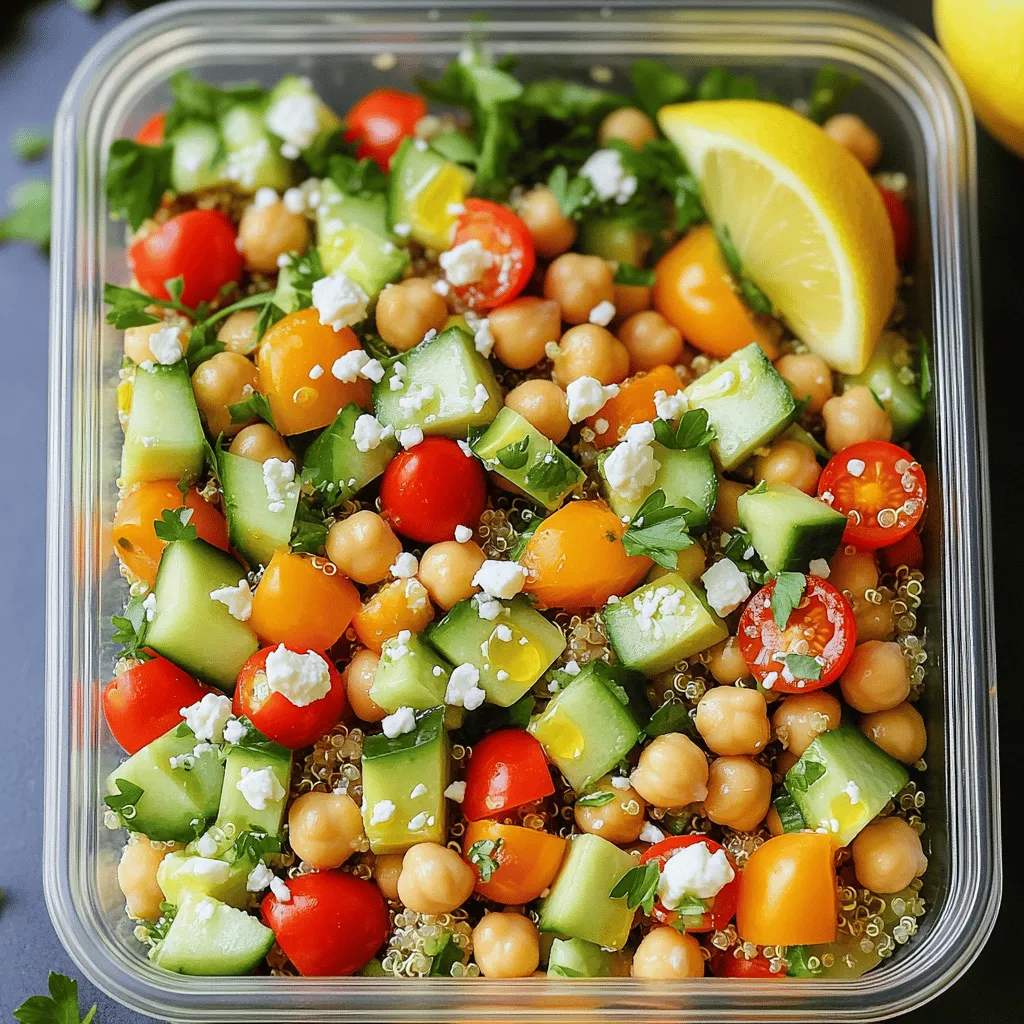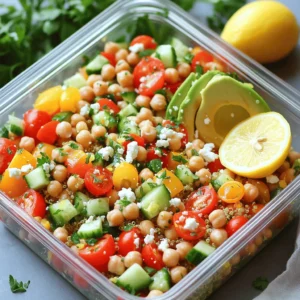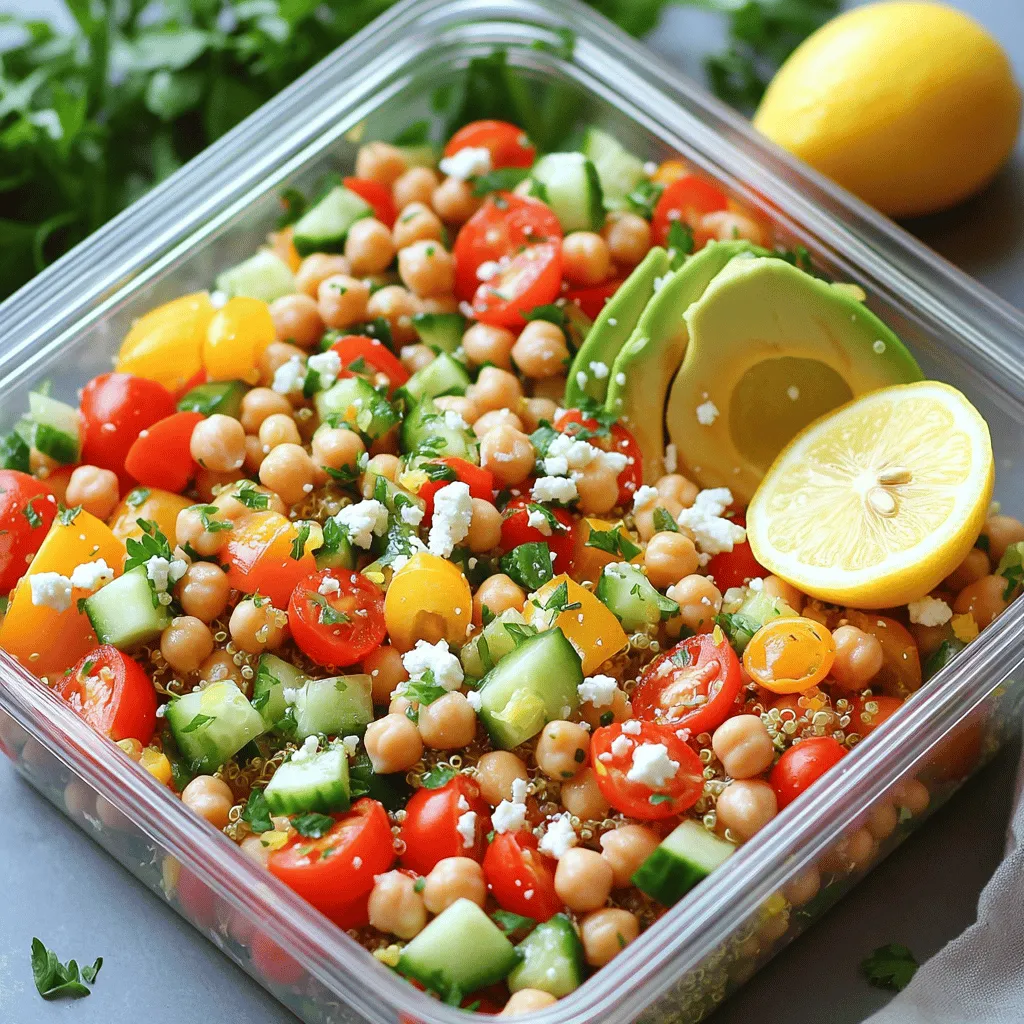Looking to boost your meal prep game with tasty and healthy options? High protein salads are the perfect solution. Packed with nutrients and flavor, these salads keep you full and energized. I’ll show you how to make them, customize them, and store them for the week ahead. Say goodbye to boring meals and hello to easy, delicious salads that fuel your goals. Let’s dive into these high protein salad recipes for meal prep success!
Ingredients
List of Ingredients for High Protein Salad
For a tasty high protein salad, gather these ingredients:
– 1 cup cooked quinoa (cooled)
– 1 cup canned chickpeas, rinsed thoroughly and drained
– 1 cup cherry tomatoes, halved
– 1 medium cucumber, diced into small cubes
– 1 bell pepper of your choice (red, yellow, or green), diced
– 1 ripe avocado, diced
– 1/4 cup feta cheese, crumbled (optional for added flavor)
– 2 tablespoons extra virgin olive oil
– 2 tablespoons freshly squeezed lemon juice
– 1 teaspoon Dijon mustard
– Salt and pepper to taste
– Fresh parsley, finely chopped (for garnish)
Optional Ingredients for Customization
You can change this salad to suit your taste. Here are some ideas:
– Add cooked chicken or turkey for extra protein.
– Use different beans, like black beans or kidney beans.
– Toss in nuts or seeds for crunch and healthy fats.
– Swap feta with goat cheese or leave it out for a dairy-free option.
– Mix in seasonal veggies like zucchini or bell peppers.
Nutritional Benefits of Key Ingredients
Each ingredient in this salad has unique benefits:
– Quinoa: A complete protein, it has all nine essential amino acids.
– Chickpeas: They boost protein and fiber, keeping you full longer.
– Avocado: Rich in healthy fats, it supports heart health and boosts flavor.
– Feta cheese: Adds calcium and protein, giving a savory touch.
– Olive oil: Packed with healthy fats, it helps reduce inflammation.
– Lemon juice: Full of vitamin C, it brightens flavors and aids digestion.
These ingredients work together to create a balanced meal. The protein helps with muscle repair, while the fresh veggies add vitamins and minerals. Enjoy this salad as part of your meal prep routine. It makes for a healthy option you can grab on busy days. For the full recipe, refer to the section above.
Step-by-Step Instructions
Preparation of Base Ingredients
Start by boiling some water. Once it’s boiling, add your quinoa. Cook it for about 15 minutes until it’s fluffy. After that, cool it down. Rinse the canned chickpeas under cold water. This step helps remove extra sodium.
Mixing the Salad Components
In a large bowl, combine the cooled quinoa and chickpeas. Stir them together well. Next, add halved cherry tomatoes, diced cucumber, diced bell pepper, and diced avocado. Gently fold these in, so the avocado stays intact. This keeps the salad fresh and colorful.
Dressing and Final Touches
For the dressing, take a small bowl. Whisk together olive oil, lemon juice, and Dijon mustard. Add salt and pepper to taste. Drizzle this dressing over the salad mixture. Use a spatula to toss everything until it gets a nice coat. If you want, sprinkle feta cheese on top. Toss lightly again to mix without breaking the cheese. Finally, add fresh parsley for a pop of color. This makes your salad look great and taste even better. For the full recipe, check back to the beginning.
Tips & Tricks
Meal Prep Tips for Longevity
To make your salads last longer, choose sturdy ingredients. Use grains like quinoa and beans for a strong base. They hold up well, even after a few days. Avoid watery veggies like cucumbers until just before eating. This keeps them crisp and fresh. Layer your ingredients in containers, placing dressing at the bottom. This way, your greens stay dry and crisp until serving.
How to Keep Salad Fresh for Days
Store your salad in airtight containers. This cuts off air and slows spoilage. Use glass containers if possible; they do a great job at keeping things fresh. If your salad has avocado or dressing, add them right before you eat. You can also try adding a damp paper towel inside the container. It helps maintain moisture without making the salad soggy.
Recommendations for Serving Sizes
When prepping, aim for about 2 cups of salad per serving. This gives you a good portion without being too much. If you have a mix of protein and veggies, you’ll feel satisfied. You can scale up or down based on your needs. For example, if you’re very active, increase the protein portion. You can find a balance that works best for you with the Power-Packed Protein Rainbow Salad.

Variations
Vegetarian and Vegan Adaptations
You can easily make high protein salads vegetarian or vegan. For a vegetarian version, simply add cheese like feta or mozzarella. If you want a vegan salad, skip the cheese and add more veggies or seeds. Nutritional yeast is a great choice! It adds a cheesy flavor without any dairy. You can also use tofu or tempeh as protein sources. They soak up flavors well and keep the meal filling.
Different Protein Sources to Include
There are many protein sources to add to your salad. Chickpeas, like in the Power-Packed Protein Rainbow Salad, are a fantastic option. You can also use lentils, black beans, or kidney beans. These legumes are rich in protein and fiber. If you eat meat, grilled chicken, turkey, or shrimp work great too. For seafood lovers, try canned tuna or salmon. Nuts and seeds are another easy way to boost protein. Almonds, walnuts, and pumpkin seeds add a nice crunch and flavor.
Seasonal Ingredient Swaps
Using seasonal ingredients can make your salad fresher and tastier. In spring, add asparagus or snap peas. Summer is perfect for ripe tomatoes and corn. In fall, try roasted sweet potatoes or squash. Winter calls for hearty greens like kale or spinach. You can mix and match to keep salads exciting! Just remember to adjust the dressing for your new ingredients. This way, you keep your meal prep fun and varied.
Storage Info
Best Practices for Meal Prep Storage
To keep your salads fresh, choose the right containers. Use airtight glass or BPA-free plastic. Divide your salad into individual portions. This way, you grab one when you need it. Always keep dressings separate until you are ready to eat. This helps keep your salad crisp and tasty. Store your salads in the fridge to maintain freshness.
How to Reheat or Refresh the Salad
Most salads are best cold, but some need a refresh. If your salad seems wilted, add a splash of lemon juice. This can perk up the flavors and freshness. For salads with grains, like quinoa, you can warm them up. Place the salad in a microwave-safe bowl. Heat it in short bursts until warm. Just remember to toss in fresh greens after heating for that crunch.
Shelf Life and Freezing Options
Salads generally last about 3 to 5 days in the fridge. After this, they may lose their taste and texture. If you want to store them longer, think about freezing. However, most salads do not freeze well due to water content. If you need to freeze, skip the dressing. You can freeze the base ingredients. When you’re ready, thaw in the fridge overnight and add fresh ingredients. Check out the Full Recipe for a delicious option to start with!
FAQs
How to Make High Protein Salad Recipes?
To make a high protein salad, start with a base. Choose grains like quinoa or brown rice. Then, add protein sources. Canned chickpeas or beans work well. You can also use cooked chicken or tofu. Mix in colorful veggies for flavor and crunch. Finally, top with a tasty dressing. My Power-Packed Protein Rainbow Salad is a great example. It combines quinoa, chickpeas, and fresh vegetables for a balanced meal.
Can these salads be frozen for future use?
Most high protein salads do not freeze well. Freezing can make the vegetables mushy. However, you can prepare the base in advance. Cook your grains and protein, then freeze them. Add fresh ingredients when you are ready to eat. This way, you keep the taste and texture fresh.
What are the health benefits of high protein salads?
High protein salads offer many health benefits. They help you feel full longer. This can aid in weight management. Protein also helps build and repair muscles. Adding various vegetables boosts vitamins and minerals. These salads are low in calories but high in nutrients, making them a smart choice for meals.
What dressings pair well with high protein salads?
For high protein salads, dressings should enhance flavors. A simple lemon vinaigrette works well. Mix olive oil, lemon juice, salt, and pepper. You can also try yogurt-based dressings for creaminess. If you like a kick, add a bit of mustard or hot sauce. These dressings complement the salad’s fresh ingredients nicely.
High protein salads offer a great mix of taste and health. We reviewed the key ingredients, tips for prep, and how to customize your salad. I shared how to keep salads fresh and tasty, plus ideas for variations. Remember, these salads are easy to make and store well too. Enjoy the benefits of a nutritious meal that fits your lifestyle. Try new ingredients and enjoy the journey to better eating.

